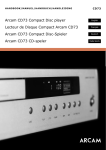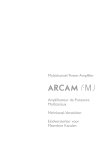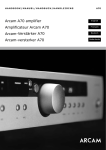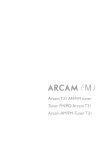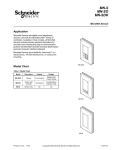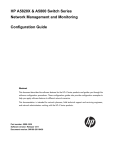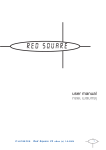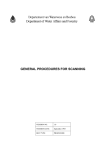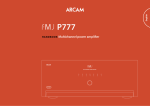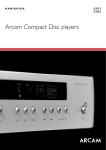Download Arcam P7 audio amplifier
Transcript
Multichannel Power Amplifier 2 Using this handbook This handbook has been designed to give you all the information you need to install, connect, set up and use the Arcam FMJ P7 Multichannel Power Amplifier. CONTENTS It may be that the P7 has been installed and set up as part of your Hi-Fi or home cinema installation by a qualified Arcam dealer. In this case, you may wish to skip the sections of this handbook dealing with installation and setting up the unit. Use the Contents list to guide you to the relevant sections. Using this handbook...................................................................... 3 Safety guidelines ............................................................................. 4 Safety instructions ..................................................................................4 Safety compliance...................................................................................4 Getting started with your P7...................................................... 5 Introduction ...............................................................................................5 Speaker installation ................................................................................5 Cables............................................................................................................5 SAFETY Safety guidelines are set out on the following page of this handbook. Installation ....................................................................................... 6 Positioning the unit ................................................................................6 Connecting to a pre-amplifier.........................................................6 Connecting to a loudspeakers ........................................................7 Connecting to a power supply .......................................................7 Many of these items are common sense precautions, but for your own safety, and to ensure that you do not damage the unit, we strongly recommend that you read them. This is a class 1 product and requires an earth connection. Operating your P7......................................................................... 8 Front panel layout ..................................................................................8 Operating procedure ...........................................................................8 OTHER LANGUAGES Bi-wiring and bi-amping your loudspeakers............................. 9 Before you start ......................................................................................9 Bi-wiring your loudspeakers .............................................................9 Bi-amping your system.........................................................................9 Check the Arcam website (www.arcam.co.uk) for further languages. Troubleshooting ........................................................................... 10 Fault status indicators........................................................................ 11 Technical specification ................................................................ 12 Guarantee...................................................................................... 13 On-line registration ............................................................................ 13 3 Safety guidelines 11. Grounding SAFETY INSTRUCTIONS Ensure that the unit is grounded properly at all times. 12. Power lines This product is designed and manufactured to meet strict quality and safety standards. However, you should be aware of the following installation and operation precautions: Locate any outdoor antenna/aerial away from power lines. 13. Non-use periods 1.Take heed of warnings and instructions You should read all the safety and operating instructions before operating this appliance. Retain this handbook for future reference and adhere to all warnings in the handbook or on the appliance. If the unit has a standby function, a small amount of current will continue to flow into the equipment in this mode. Unplug the power cord of the appliance from the outlet if left unused for a long period of time. 2. Water and moisture 14. Abnormal smell The presence of electricity near water can be dangerous. Do not use the appliance near water – for example next to a bathtub, washbowl, kitchen sink, in a wet basement or near a swimming pool, etc. If an abnormal smell or smoke is detected from the appliance, turn the power off immediately and unplug the unit from the wall outlet. Contact your dealer immediately. 3. Object or liquid entry 15. Servicing Take care that objects do not fall and liquids are not spilled into the enclosure through any openings. Liquid filled objects such as vases should not be placed on the equipment. You should not attempt to service the appliance beyond that described in this handbook. All other servicing should be referred to qualified service personnel. 4.Ventilation 16. Damage requiring service Do not place the equipment on a bed, sofa, rug or similar soft surface, or in an enclosed bookcase or cabinet, since ventilation may be impeded. We recommend a minimum distance of 50mm (2 inches) around the sides and top of the appliance to provide adequate ventilation. Do not place other equipment directly on top of the unit. The appliance should be serviced by qualified service personnel when: A. the power-supply cord or the plug has been damaged, or B. objects have fallen, or liquid has spilled into the appliance, or 5. Heat C. the appliance has been exposed to rain, or Locate the appliance away from naked flames or heat producing equipment such as radiators, stoves or other appliances (including amplifiers) that produce heat. D. the appliance does not appear to operate normally or exhibits a marked change in performance, or E. the appliance has been dropped or the enclosure damaged. 6. Climate 17. Lifting the unit The appliance has been designed for use in moderate climates. This amplifier weighs 31kg, so take extreme care when lifting or moving this unit. We recommend that two people are available to lift this unit. 7. Racks and stands Only use a rack or stand that is recommended for use with audio equipment. If the equipment is on a portable rack it should be moved with great care, to avoid overturning the combination. As this amplifier weighs 31kg, ensure that the equipment rack or stand is sturdy enough to support this weight. SAFETY COMPLIANCE This product has been designed to meet the EN60065 international electrical safety standard. 8. Cleaning Unplug the unit from the mains supply before cleaning. The case should normally only require a wipe with a soft, damp, lintfree cloth. Do not use paint thinners or other chemical solvents for cleaning. We do not advise the use of furniture cleaning sprays or polishes as they can cause indelible white marks if the unit is subsequently wiped with a damp cloth. Do not spray cleaning products into the ventialtion slots on top of the unit. 9. Power sources Only connect the appliance to a power supply of the type described in the operating instructions or as marked on the appliance. 10. Power-cord protection Power supply cords should be routed so that they are not likely to be walked on or pinched by items placed upon or against them, paying particular attention to cords and plugs, and also the point where they exit from the appliance. 4 Getting started with your P7 INTRODUCTION SPEAKER INSTALLATION The P7 Multi-channel Power Amplifier is built to Arcam’s traditional high quality design and manufacturing standards. It is an extremely high-performance multi-channel power amplifier, offering up to 150W per channel. It is obviously well suited to multi-channel home cinema amplification, and also provides superb quality stereo performance with two-channel sources. The P7 is an ideal partner for the FMJ AV8 Pre-amp Processor. The P7 allows connection of up to seven loudspeakers (for typical 5.1 and 7.1 installations). The speakers are distributed in the front left, centre, front right, surround left, surround right, surround back left, surround back right (see diagram below) Front left Each power amplifier module is identical, and is electrically isolated from the other modules by opto-isolated circuitry which ensures that each amplifier module has its own isolated supply. This allows the amplifier to give excellent channel separation and very low distortion. Centre Front right Subwoofer The P7 also has input and output phono sockets for the signal being fed to each channel, to allow the signal to be passed on to additional power amplifiers to drive loudspeakers in other rooms or to bi-amplify any of the speakers. If the P7 is being used to drive a five-channel surround sound system, then the spare two modules (‘L surround rear’ and ‘R surround rear’) can be used in conjunction with the main (‘L front’ and ‘R front’) modules to bi-amplify suitable front left and right speakers. Surround right Surround left Surround back left Surround back right All speakers, with the exception of the subwoofer, should be arranged around your normal viewing/listening position (see diagram). The subwoofer can be placed almost anywhere and we recommend experimenting with it in various positions to obtain the best result. NOTE: For speakers to be suitable for bi-amping, they must have separate input terminals for bass (LF) and treble (HF) and any links between these terminals must be removed before using the P7 in this way. Position your front left and right speakers to achieve a good stereo image for normal musical reproduction as well as for the multi-channel modes. If they are placed too close together there will be a lack of spaciousness. Alternatively if they are placed too far apart the stereo image will appear to have a large hole in the middle and will be presented in two halves. The P7 can be easily integrated with various types of loudspeakers currently available, including those that are THX certified. Being THX certified means that the P7 has passed the rigorous THX Ultra2 specification enabling it to reproduce THX Surround EX signals from both Dolby Digital and DTS soundtracks, when fed from a THX Surround EX-capable processor, such as the Arcam AV8. The centre speaker allows for a more realistic reproduction of dialogue and centre sounds as well as wider and better imaging for stereo effects and background sounds for home cinema use. Do not compromise on the quality of your centre speaker as it carries all the dialogue for a home cinema system. The customised installation of the P7 to a listening room is an important process which requires care at every stage For this reason, the installation information is very comprehensive and should be followed carefully. This manual has been written with the assumption that the installer is familiar with the installation of audio/video systems. The surround left and right speakers reproduce the ambient sound and effects present in a multi-channel home cinema system. The surround back left and surround back right speakers are used to add extra depth, a more spacious ambience and sound localisation. A subwoofer will greatly improve the bass performance from your system. This is useful for reproducing special cinema effects, especially where a dedicated LFE (Low-Frequency Effects) channel is available, as with Dolby Digital or DTS Digital Surround encoded discs. CABLES We recommend the use of high quality screened analogue, digital and video cables as inferior quality cables will degrade the sound and picture quality of your system. Only use cables that are designed for the particular application as other cables will have different impedance characteristics that will degrade the performance of your system. Speaker cable length should be minimized and low resistance wire should be used throughout to ensure efficient power transmission and avoid audible distortion. For optimum soundstage imaging, try to keep the right and left speaker cables the same length. You are also advised to route the signal cables, speaker cables and mains power cables away from each other to minimize interference. 5 Contact your Arcam dealer or installer for details of suitable cables. Installation IN AUDIO OUT IN AUDIO OUT + IN AUDIO OUT + – 4-16 OHMS 7. RS BACK POWER INLET 50 – 60 HZ ~230V 3700 VA MAX 5. R FRONT IN AUDIO OUT + 4-16 OHMS 4. CENTRE IN AUDIO OUT + – – 4-16 OHMS 6. R SURR AUDIO OUT + – 4-16 OHMS IN 3. L FRONT AUDIO OUT + – 4-16 OHMS IN + – 4-16 OHMS 2. L SURR – 4-16 OHMS 1. LS BACK 12V TRIGGER IN POSITIONING THE UNIT CONNECTING TO A PRE-AMPLIFIER Place the amplifier on a level, firm surface. ANALOGUE AUDIO INPUTS Avoid placing the unit in direct sunlight or near sources of heat or damp. It is imperative to connect the pre-amplifier outputs to the module for that particluar channel, e.g. connect the left surround output to the module that will be driving the left surround speaker. Do not place the unit on top of a power amplifier or other sources of heat. All modules are identical, however, we advise you to make connections corresponding to rear panel labelling, since the amplifier modules are muted in pairs. Due to the layout of the power supply circuitry in the P7, you should connect the correct input signal and loudspeaker to the recommended channel, or the left/right stereo imaging will not be optimum. Ensure adequate ventilation. The P7 has a variable speed fan for cooling. If the unit is placed in an enclosed space, such as a bookcase, equipment rack or cabinet, ensure that there is adequate space and ventilation in the enclosure for air to flow through the ventilation slots and cool the amplifier. Inadequate cabinet ventialtion may cause the P7 to shut down due to thermal overload. The outputs from the pre-amplifier should be connected to the AUDIO IN inputs on the P7. Be sure to note which channel from the pre-amplifier is connected to which power amplifier module, so that the correct speaker can be connected to that module and the correct channel identity can be maintained. The amplifier is designed to run warm during normal operation. Ensure that the equipment rack or stand can support the 31kg weight of the unit. If you wish to use four modules to bi-amplify a pair of speakers, or would like to bi-amplify using another power amp, then you can take the signal for that channel and feed it on to the additional modules using the AUDIO OUT phono socket on that module. The signal is then fed in to the first module, but also fed on to the second module so that both modules can bi-amplify the loudspeaker. 12V TRIGGER INPUT If your pre-amp provides a 12V Trigger output, it can be connected to the 12V TRIGGER IN socket using a 3.5mm jack.This enables the P7 to be turned on remotely from the pre-amp. Note that the trigger input is only active when the central power button on the front panel is depressed. 6 Outputs from multichannel pre-amp (e.g. AV8) R surround R rear surround IN OUT OUT IN + + – + R front + IN OUT + L L surround surround rear OUT IN IN + – OUT + – IN OUT + – – + Arcam P7 power amplifier HF LF OUT – – – + IN L front Centre – HF – + + – HF + LF + ... etc. ... LF – – HF + – LF – Basic wiring of loudspeakers (three channels omitted for clarity) I CONNECTING TO LOUDSPEAKERS CONNECTING TO A POWER SUPPLY The speakers should be connected to the loudspeaker terminals, as per the correct input signal. In other words, the Centre channel speaker should be connected to the module that is being fed the signal for the Centre channel, and so on, for all the channels. WRONG PLUG? Check that the plug supplied with the unit fits your supply and that your mains supply voltage agrees with the voltage setting (100V, 115V or 230V) indicated on the rear panel of the unit. As with all speaker connections, ensure that polarity is maintained when connecting the speakers (i.e. red (+) to red; black (–) to black). If your mains supply voltage or mains plug is different, consult your Arcam dealer or Arcam Customer Support on +44 (0)1223 203203. To bi-wire or bi-amplify your speakers, refer to the section towards the end of this Handbook where diagrams are provided. If you are unsure as to how your system should be connected, or need advice on biamping, please consult your Arcam dealer. MAINS LEAD The appliance is normally supplied with a moulded mains plug already fitted to the lead. If for any reason the plug needs to be removed, it must be disposed of immediately and securely, as it is a potential shock hazard when inserted into the mains socket. Should you require a new mains lead, contact your Arcam dealer. PLUGGING IN Push the plug (high current IEC line socket) of the power cable supplied with the unit into the POWER INLET socket in the back of the unit. Make sure it is pushed in firmly. The P7 has been designed so that a standard-rating IEC cable (which has insufficient current rating) cannot be plugged into the P7. Only high current power cables can be connected. Put the plug on the other end of the cable into your power supply socket and switch the socket on. 7 Operating your P7 P7 MULTICHANNEL POWER AMPLIFIER 1 2 3 4 FRONT PANEL LAYOUT 5 6 7 OPERATING PROCEDURE The P7 front panel has a single control: a centrally located power on/off button. Once the relevant connections have been made, the P7 can be switched on using the central button on the front panel. POWER SWITCHING ON Switches the unit on and off. Note that the modules are turned on individually to stagger the surge created when a powerful amplifier is switched on (i.e. it provides a ‘soft start’). This reduces the surge current drawn from the domestic power supply. It is recommended that you switch on your pre-amp or controller before powering up the P7 power amp. Normal powering up is indicated by the following sequence of front panel LED indicators: 1. On pressing the power switch, all LEDs turn red. 2. After approximately half-a-second, the centre LED turns amber. 3. The LEDs cycle through red, orange, then green to indicate the status from powered-up (initialised), stabilised and active respectively. The LEDs continue turning amber from the centre to the edges in pairs, with intervals of approximately one second. 4. The centre LED turns green and a relay ‘click’ is heard. All LEDs are off in standby mode. 5. The LEDs continue turning green from the centre to the edges in pairs, along with relay ‘clicks’, with intervals of approximately one second. POWER/STATUS LEDS A separate LED indicates the status of each of the seven channels of the P7. If the LEDs do not follow this sequence when the P7 is powered up, or behave abnormally at any time during use, then consult the table of ‘Fault status indicators’ on page 11 to discover why the amplifier is in protection mode. NOTE: It is recommended that if the unit is switched off, then it should not be switched on again for at least 20 seconds from when it was turned off. This allows the amplifier’s power supply to discharge fully before it is switched on again. SWITCHING OFF To shut down, switch the P7 power amp off first, followed by the preamp or controller. This eliminates the chance of any ‘thumps’ or power spikes being fed through to the power amplifier and potentially causing damage to the system. 8 Bi-wiring and bi-amping loudspeakers BEFORE YOU START BI-AMPING YOUR SYSTEM The performance of your system can be further enhanced over that achieved with bi-wiring, by extending the principle one stage further to include separate amplification for the low and high frequency drive units in each loudspeaker enclosure. WARNING: Do not make any connections to your amplifier while it is switched on or connected to the mains supply. Before switching on please check all connections thoroughly, making sure bare wires or cables are not touching the amplifier in the wrong places (which could cause short circuits) and you have connected positive (+) to positive and negative (–) to negative. To bi-amplify your speakers, connect the speaker terminals from one module to one pair of terminals on the speaker. Connect another module, or one channel of a separate power amp, to the other pair of terminals on the speaker, so that two amplifier channels are connected to that speaker; one for low frequencies and one for high frequencies. Always ensure that the volume control on your amplifier is set to minimum before starting these procedures. BI-WIRING YOUR LOUDSPEAKERS Ensure that in all cases, the positive terminals on the speakers are connected to the positive (red) terminals on the amplifier, and similarly for the negative (black) terminals. Bi-wiring improves the sound of your system because it divides the high and low frequency signal currents into separate speaker cables. This avoids signal distortions arising from the high and low frequency currents interacting with one another within a single cable, as in conventionally wired systems. NOTE: In order to bi-amplify your speakers, your speakers will need to be bi-wirable, and have positive and negative terminals for both high frequency (HF) and low frequency (LF) information. If your speakers are bi-wirable, ensure that the links between the HF and LF terminals are removed. You will need: Speakers – with four input terminals each: these will be marked (High Frequency + and –) and LF (Low Frequency + and –). How to set up a bi-amped system HF 1. Loudspeaker cables – two pairs of cables per loudspeaker (which may be joined at the amplifier end if your amplifier has only one pair of output terminals per channel, as is the case with P7). Or, a suitably terminated cable set (a loom, probably prepared by your dealer and capable of being used for bi-wiring in one length). WARNING:This step is essential or damage to your amplifier may result which is not covered under warranty. How to bi-wire loudspeakers 1. Remove the terminal links on the rear of your loudspeakers. NOTE: If you do not remove the shorting links from the speaker terminals, the speakers will still be single-wired! 2. Remove the terminal links on the rear of your loudspeakers. 2. Connect the cables as shown in the diagram below, ensuring correct polarity at all times. 3. Use interconnect cables to connect the OUT socket of the first channel to the corresponding IN socket of the adjacent channel of the power amplifier. Connect the cables as shown in the diagram below, ensuring correct polarity at all times. Arcam P7 power amplifier IN Arcam P7 power amplifier OUT IN + – + OUT + – + – LF + – – HF + OUT IN HF + – LF – Recommended bi-amping configuration Bi-wiring using one set of connections on amplifier 9 Troubleshooting NO LIGHTS ON THE UNIT HUM ON AN AMPLIFIER OUTPUT Check that: Check that: the power cord is plugged into the P7 and the mains socket all cables are making a good connection. If necessary withdraw outlet it is plugged into is switched on. the cable from the connector and plug it back in again. (Turn the power off before doing this) the plug fuse has not failed, or a circuit-breaker earlier in the if the hum originates from a ground loop caused by an aerial, power supply path has not opened. satellite dish or cable supply, you should contact your aerial contractor. the power button is pressed in. the signal (interconnect) leads are not wrapped around a mains RED LED PRESENT lead. Refer to the ‘Fault Status Indicators’ table if you have an unusual sequence of LEDs. try switching the ground lift on the back panel of the processor (if available). NO SOUND IS PRODUCED THERE IS RADIO/TELEVISION RECEPTION INTERFERENCE Check that: the correct input has been selected on the pre-amp. you have assigned the digital input to the correct input source. The P7 has been designed to a very high standards of electromagnetic compatibility. the volume is turned up to a reasonable level and ‘MUTE’ is not Check that: displayed on the front panel display on the pre-amp. the aerial/dish cable is routed as far as possible from your P7 and its cabling. your power amplifier(s) are turned on and working correctly. the cabling used from the aerial/dish is of high quality and screened. SOUND IS POOR AND BADLY DISTORTED repositioning the receiving aerial/dish as far as possible from Check that: your P7 and its cabling may bring an improvement. all cables are making a good connection. If necessary withdraw if the problem persists, contact your aerial contractor. the cable from the connector and plug it back in again. (Turn the power off before doing this) you are using high quality screened audio cable between your equipment and that no cables are broken or damaged. you have selected the correct size of speakers to suit your system in the setup menu of the processor or pre-amp. SOUND ONLY COMES FROM SOME OF THE SPEAKERS Check that: all speakers in the system are connected to the P7. you have configured your pre-amp to include all the speakers in your system. you have an appropriate surround sound source selected and playing through the pre-amp. for digital sources, check the player is outputting multichannel data. With some DVD players you are able to select in what format multi-format encoded discs are outputted, and whether multichannel data is down mixed to PCM (stereo). the disc you are playing is a multichannel recording and that the processor is outputting multichannel audio. your speaker balance is correct. all amplifiers are turned on and all channels are working correctly. all units are turned on. If the audio is ‘daisy-chained’ from the P7, make sure that the unit being fed is turned on. 10 FAULT STATUS INDICATORS The LED patterns below indicate the following fault conditions: LED status Description Amplifier action All LEDs are green This is the normal operating state of the amplifier. None During power up all LEDs stay red for an extended time The amplifier is waiting for the DC offset fault lines to clear. A DC offset fault can occur if an excessive DC voltage is present at the output of the pre-amp feeding the P7. Normal operation resumes if the lines clear in 20 seconds. To verify excessive DC offset voltage, remove the interconnect leads (with the P7 switchd off) and turn on the P7. The fault should have cleared. During power up or normal operation, one or more LEDs are flashing green, with the remaining LEDs solid red The DC fault cannot be cleared. The channels with the flashing green LEDs represent the amplifier modules that have a DC offset fault. Alternatlively, a DC offset fault has reoccurred on the same channel within 12 seconds of a previous DC offset fault clearance. The amplifier shuts down. The power switch must be cycled to reset the amplifier (cycling the trigger does NOT reset the amplifier). During power up or normal operation, one or more LEDs are flashing green, with the remaining LEDs NOT solid red The amplifier is attempting to clear a DC offset fault on a channel with the flashing green LED. The amplifer mutes the channel with the fault and its paired channel. The amplifier stays in this state for up to two seconds or until the fault clears (whichever is sooner). During power up or normal operation, one or more LEDs are flashing red, with the remaining LEDs solid red A short circuit fault cannot be cleared. The flashing red LEDs represent the amplifier modules with a short circuit fault. Alternatlively, a short circuit fault has reoccurred on the same channel within 12 seconds of a previous short circuit fault clearance. The amplifier shuts down. The power switch must be cycled to reset the amplifier (cycling the trigger resets the amplifier). During power up or normal operation, one or more LEDs are flashing red, with the remaining LEDs NOT solid red The amplifier is attempting to clear a short circuit fault on a channel with the flashing red LED. The amplifer mutes the channel with the fault and its paired channel. The amplifier stays in this state for up to half-a-second or until the fault clears (whichever is sooner). During power up or normal operation, one or more LEDs are flashing amber The amplifier is attempting to clear an over temperature fault on a channel with the flashing amber LED. The amplifer mutes the channel with the fault and its paired channel and the fan is set to maximum speed. The amplifier stays in this state until the channel has cooled. During power up or normal operation, one LED is flashing amber, with the remaining LEDs solid red An over temperature fault has reoccurred on the same channel within 12 seconds of a previous over temperature fault clearance.The flashing amber LEDs represent the amplifier modules with an over temperature fault. The amplifier shuts down. The power switch must be cycled to reset the amplifier (cycling the trigger resets the amplifier). During power up or normal operation, all the LEDs are flashing amber The amplifier is attempting to clear an over temperature fault on more than one channel, or the power transformers have overheated. The amplifer mutes all channels and the fan is set to maximum speed. The amplifier stays in this state until all channels have cooled, or the transformer has cooled. During normal operation, all the LEDs are solid red An over temperature fault has reoccurred on one or more channels, or the power transformers have overheated within 12 seconds of a previous over temperature fault clearance. The amplifier shuts down. The power switch must be cycled to reset the amplifier (cycling the trigger resets the amplifier). During power up or normal operation, one or more LEDs are flashing amber, with the remaining LEDs flashing green A DC offset fault occurred on one or more channels while attempting to clear a multiple over temperature fault. The amplifier shuts down. The power switch must be cycled to reset the amplifier (cycling the trigger does NOT reset the amplifier). During power up or normal operation, one or more LEDs are flashing amber, with the remaining LEDs flashing red A short circuit fault occurred on one or more channels while attempting to clear a multiple over temperature fault. The amplifier shuts down. The power switch must be cycled to reset the amplifier (cycling the trigger resets the amplifier). 11 Technical specifications All measurements are with 230V/50Hz mains power Continuous output power All channels driven, 20Hz—20kHz, 8Ω All channels driven, 20Hz—20kHz, 4Ω One or two channels driven at 1kHz, 8Ω One or two channels driven at 1kHz, 4Ω One or two channels driven at 1kHz, 3.2Ω 150W per channel 230W per channel 160W per channel 250W per channel 300W per channel 1.05kW total 1.62kW total Peak output current capability ±25A per channel Total harmonic distortion At any level up to rated power, into 4 or 8Ω <0.05% (20Hz—20kHz) typically <0.005% at 1kHz Frequency response ±0.2dB (20Hz—20kHz) –1dB at 1Hz and 100kHz Residual hum and noise Ref. full power –122dB, 20Hz–20kHz, unweighted Voltage gain x 28.3 (1V input gives 100W/8Ω output) Input impedance 22kΩ in parallel with 470pF Output impedance 50mΩ at 20Hz, 1kHz 120mΩ at 20kHz Power requirements 115V or 230VAC, 50/60Hz, 3kW maximum via heavy duty IEC mains inlet A soft start system eliminates large inrush currents at switch on Physical Dimensions: W430 x D450 x H180 mm Weight: 31kg (68 lb) nett; 35kg (77 lb) packed E&OE CONTINUAL IMPROVEMENT POLICY RADIO INTERFERENCE Arcam has a policy of continual improvement for its products. This means that designs and specifications are subject to change without notice. The P7 is an audio device which has been designed to very high standards of electromagnetic compatibility. The unit can radiate RF (radio frequency) energy. In some cases this can cause interference with FM and AM radio reception. If this is the case, keep the P7 and its connecting cables as far from the tuner and its aerials as possible. Connecting the P7 and the tuner to different mains sockets can also help to reduce interference. NOTE: All specification values are typical unless otherwise stated. EC COUNTRIES – These products have been designed to comply with directive 89/336/EEC. USA – These products comply with FCC requirements. 12 Guarantee WORLDWIDE GUARANTEE For further details contact Arcam at: This entitles you to have the unit repaired free of charge, during the first two years after purchase, at any authorised Arcam distributor provided that it was originally purchased from an authorised Arcam dealer or distributor. The manufacturer can take no responsibility for defects arising from accident, misuse, abuse, wear and tear, neglect or through unauthorised adjustment and/or repair, neither can they accept responsibility for damage or loss occurring during transit to or from the person claiming under the guarantee. Arcam Customer Support Department, Pembroke Avenue, Waterbeach, CAMBRIDGE, CB5 9PB, England Telephone: Fax: Email: +44 (0)1223 203203 +44 (0)1223 863384 [email protected] PROBLEMS? Always contact your dealer in the first instance. THE WARRANTY COVERS: If your dealer is unable to answer any query regarding this or any other Arcam product please contact Arcam Customer Support on +44 (0) 1223 203203 or write to us at the above address and we will do our best to help you. Parts and labour costs for two years from the purchase date. After two years you must pay for both parts and labour costs.The warranty does not cover transportation costs at any time. CLAIMS UNDER GUARANTEE ON LINE REGISTRATION This equipment should be packed in the original packing and returned to the dealer from whom it was purchased, or failing this, directly to the Arcam distributor in the country of residence. It should be sent carriage prepaid by a reputable carrier -– NOT by post. No responsibility can be accepted for the unit whilst in transit to the dealer or distributor and customers are therefore advised to insure the unit against loss or damage whilst in transit. You can register your Arcam product on line at: www.arcam.co.uk/reg 13 NOTES 14 15 PEMBROKE AVENUE, WATERBEACH, CAMBRIDGE CB5 9PB, ENGLAND telephone +44 (0)1223 203203 fax +44 (0)1223 863384 email [email protected] website www.arcam.co.uk Issue 1 SH100E

















